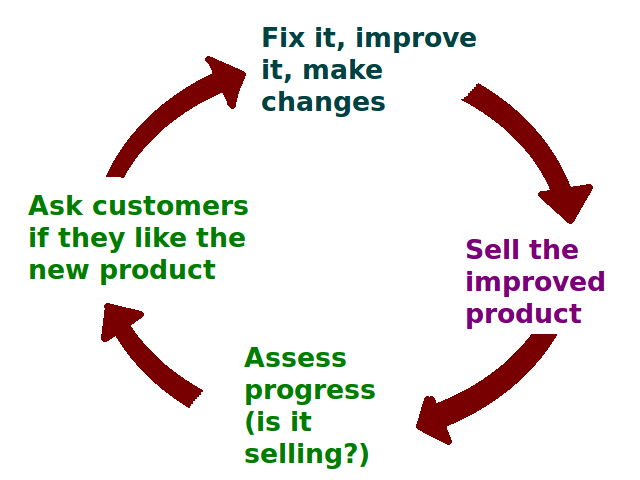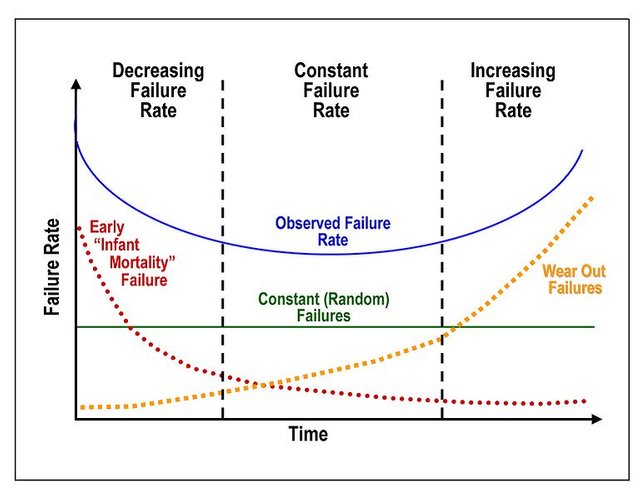Deep Thought: Reliability of Electrical And Electronics Systems #1
The motive or goal of manufacturers is to market, sell their products and make maximum profit while the goal of consumers is to buy what they deemed fit or sees as the best.
Of-course everybody wants to have what he/she sees as the best, everyone wants to purchase the best gadgets, laptops, charger, T.V sets and other electrical or electronic appliances when he/she visits any store. Virtually everyone asks is this product original? would it last, is it efficient(does this charger charges fast)? and similar questions. Little do they know, if at all they know the right engineering terminologies to use as it relates to electrical or electronic appliances. Even manufactures of the any appliance wants to get the best if they are exposed to purchasing and appliance entirely difference from what they produce.

source:wikimedia||license:CCo 1.0 Public domain
So a common factor that ensures that the goal of the manufacturers and the goal of the consumers is simultaneously achieveed to a very large extent is reliability
Introduction
Reliability is the trust-worthiness of an electrical or electronics appliance. It is the degree on which an appliance can perform the required function, at a required time, provided all the specifications and criteria are adhered to. For a wrist watch that the user manual specified users should avoid contamination with water, then a user dived into a swimming pool with it; we can say that the user has breached the specification of the wrist watch for optimum reliability. So the user is to be blamed on the ensuing fault or failure of the wristwatch. So also someone lightning an incandescent electric bulb under rainfall, of-course the effect of rainfall on the bulb will definitely cause it to fail due to heat produced by an incandescent bulb. Reliability sake is the reason user manual is included in gadgets; and some specification and mode of operation inscribed in the body or packages of electronic appliancesOverview of Reliability Concept
Decades ago, in the 1950s, a tremendous increase which is on exponential rate was witnessed in the use of electrical and electronics appliances. This resulted in more consumers complaining that the appliances the purchased stopped functioning(failure) after a short period of time, this vast complains simply implies that the reliability of the then electrical or electronic appliances were very low or that the probability of failure was very high. The consequences of this unreliability were on the increase in the lives of consumers, operating personnel and even manufacturers loose the products/projects they invested money and time on to achieve. All these became a major concern to the US defense department. On the venture to improve reliability and grant maximum convenient while using electrical or electronic appliances, the US defense department formed an organization called Advisory Group on the Reliability of Electronic Equipment (AGREE). The essence of this organisation is to investigate the reliability of equipment used by the US military. After much investigations, AGREE came out with some principles that to be adhered to so as to optimize reliability in equipment which are:
- That new appliances should be tested many hours and under worst possible conditions/weather such as high and low temperature, bad humidity and other environmental factors so as to improve its reliability before the appliance is pushed to the market.
- That the actual MTBF be higher than the rated MTBF. MTBF is an acronym for mean time before failure, it is a measure of the duration an appliance would be able to perform its required function before it fails provided the mode of operation is adhered to.This entreats manufactures to specify a lower MTBF that the actual MTBF.

source:Wikimedia||license:public domain
So assuming the number of hours a gadget will perform before it fails is 6000hrs, manufactures should rate it something significantly below 6000hrs; maybe 5000hrs - That reliability test should be carried out on all development stages of an appliance. This emphasize that during all the stages of production, reliability should be tested. Using the production of mobile phone as an example: after coupling the audio part, a reliability test should be carried out on it; the same pattern should be followed after constructing the charging subsystem and charger, the encoding and decoding subsystem; and the SIM card channel subsystem. Reliability test should be carried out on all subsystems before coupling the system.
- That reliability of all components (even the least component) making up a system should be optimized. This is so necessary because a fault as common as the "the break down of a resistor" can cause an entire system or appliance to fail.
Effects Of Unreliabilty or Low Reability
Reliabilty is the probability that an item or appliance will perform the required function under certain specifications, it should be close too unity(1) for optimum reliability. Unreliability is the opposite of reliability, that is the probability that an appliance will not be able to perform the required task at the required time even when the specifications are met. The higher the degree of uncertainty, the higher the the inconvenient it will give to both manufacturers , suppliers and consumers. Almost everyone that has spend some decades on this earth has fallen victim of the consequences of unreliability. Most people here in Nigeria, have purchased a mobile charger only for it to fail(be in bad condition) after few weeks.The consequences of unreliability might be deadly in some cases. The consequences are summarized below:
- Inconvenience and dissatisfaction of suppliers and consumers: Imagine that five hundred consumers purchase a particular phone model in a week, then on getting home, they discovered that after charging the mobile phone fully, it could battery could not last up-to 3-hours even when not actively used. Those consumers will pass through the inconvenience of carrying their chargers even to a job interview, hence this makes them regret buying the gadget. Some will be displeased to the extent of returning the phone to the shop they purchased it from with a demand for complete refund or another phone model. This in-turn inconvenient the suppliers who will be getting various complaints and demand for refund of item already recorded in sales journal.
- Accident And Death of individuals operating the device: unreliability can lead to accident that has the potency of causing death to individual(s).
Some years back , news of Samsung Galaxy exploding or catching fire while being charged flooded the internet. It was reported that the Samsung Galaxy S7 purchased by a 20-year old Korean lady caught fire while she was charged with the original charged, traces or granules from the fire burnt the lady's furniture and gave her some injuries on her hand ref - Loss of Revenue and Appliance To The Manufacturers: unreliability can lead to loss of profit/revenue to the engineers producing the device. Using the fire outbreak of Samsung Galaxy as example; at a point, Samsung inc summoned customers/users that fell victim of the phone's explosion to go to a nearby accredited Samsung office close to them, and get a full refund of their burnt gadgets. Samsung has to pay people back from profit already recorded in their journal. The phones were burnt beyond repair, so Samsung did not just loose profit, but some parts of the money invested on that particular phone. In addition to these, the unreliability dents the reputation of any production company.
Base on all these consequences of unreliability to consumers, everyone asks questions like does it last, does it charge fast, is it original? and similar questions afore-mentioned in the beginning of this article. What everyone actually has in mind at the point of purchase is the reliability of the item being purchased. And for reliability close to unity, the appliance must always be in the state or ready to perform the function of which it is designed to(availability). For a mobile charger to be highly reliable, it has to start charging immediately it is plugged to a source and connected to the mobile phone; one must not wait for even some minutes for the charger to start charging the mobile phones. Again for a mobile charger to be highly reliable, it must retain its original characteristics/features throughout its useful lifespan(quality). If it takes 3hours for a follow-come charger to charge a particular phone fully(0-100%), it should be charging the same phone fully in 3hours throughout its MTBF.
The Objectives Of Reliability
Unreliability has caused more harm than good to producers and consumers. This triggered some targets in the thoughts of producers which consummates to improving reliability. These targets are enlisted below:- To apply specialist knowledge and techniques, so as to prevent or mitigate the frequency of failure(failure rate) or the likelihood of failure. Failure rate is the number of times an device fails(incapacitated to perform the required function) at a given time or the ratio of number of appliances that fails out of many systems(appliance) sampled.

source:wikimedia||license:Public domain
A very low failure rate contributes to a high level of reliability. This is seen from the mathematical relationship:
R(t) = e- λt
where:
R(t) = Reliabilty
t= time
λ= failure rate - To troubleshoot and correct the causes of failure despite the preventive measures taken. troubleshooting can simply be done with a electric quantity measuring meters.
- To provide a means of coping with any failure that developed, even when its cause or fault that led to the failure has not being corrected. This is seen in transformers connected in parallel, if one of the transformers fails, the maintenance engineers will disconnect the transformer that failed without interrupting the power supply to consumers, There would no be power failure despite the transformer failure. Hence, the power system will still cope with the failure until the cause is corrected.
- To apply various methods for predicting the likely reliability of new designs, and for analyzing reliability data.
Conclusion
Reliability of devices, items or equipment is so important that a department of Reliability Engineering has being created in various institutions. Negligence of reliability while designing items can cause frustration, dissatisfaction , accidents and eventually death. Everyone has a part to play to ensure reliability, incorporating user manuals in devices is a part for manufacturers while adhering to the instructions of user manual is the part of the consumer. Finally, reliability is a like a circle, no one is left out.
References
- Overview on reliability of electronic appliances
- Samsung phone explosion
- Failure rate of electronic systems
- The Aims of reliability
- History of reliabilty engineering
- Transformers connected in parallel
- The relevance of bathtub curve in reliability Engineering
- safety and risk in engineering design
- Engineering design analysis
This post has been voted on by the SteemSTEM curation team and voting trail in collaboration with @curie.
If you appreciate the work we are doing then consider voting both projects for witness by selecting stem.witness and curie!
For additional information please join us on the SteemSTEM discord and to get to know the rest of the community!
This article brings back memories of school days and some of those courses we have no option but to sit through it :)
Reliability of manufactured product is of utmost importance, what I do is to add mine after the specification recommended theirs- e.g. if a light bulb is said to last for 10000 hours, I just assume it'd last for 70% of that time or 7000 hours. That way you'd never be disappointed :)
That's true. Even AGREE recommended that manufacturers should do such. So if set limits are adhered to, the real life time would be more than the life time described
Thanks for your quality time @greenrun
:)